牛津译林版-英语-四年级上册-译林4AUnit2教案
- 格式:doc
- 大小:93.50 KB
- 文档页数:11
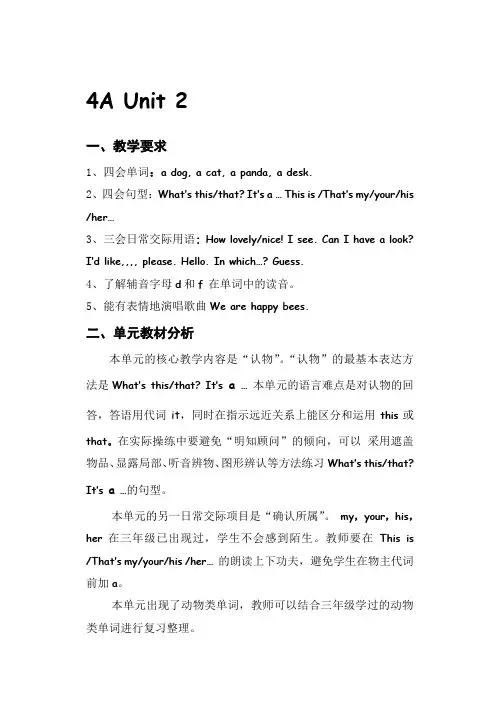
4A Unit 2一、教学要求1、四会单词:a dog, a cat, a panda, a desk.2、四会句型:What’s this/that? It’s a … This is /That’s my/your/his /her…3、三会日常交际用语: How lovely/nice! I see. Can I have a look? I’d like,,,, please. Hello. In which…? Guess.4、了解辅音字母d和f在单词中的读音。
5、能有表情地演唱歌曲We are happy bees.二、单元教材分析本单元的核心教学内容是“认物”。
“认物”的最基本表达方法是What’s this/that? It’s a … 本单元的语言难点是对认物的回答,答语用代词it,同时在指示远近关系上能区分和运用this或that。
在实际操练中要避免“明知顾问”的倾向,可以采用遮盖物品、显露局部、听音辨物、图形辨认等方法练习What’s this/that? It’s a …的句型。
本单元的另一日常交际项目是“确认所属”。
my,your,his,her在三年级已出现过,学生不会感到陌生。
教师要在This is /That’s my/your/his /her… 的朗读上下功夫,避免学生在物主代词前加a。
本单元出现了动物类单词,教师可以结合三年级学过的动物类单词进行复习整理。
Unit 2 (第一课时)一、教学内容B Look read and learn &C Ask and answer二、教学目标1、能正确地听、说、读单词a dog, a cat, a tiger, a panda, a rabbit,a bear, a lion, a monkey2、能听得懂、会说、会读和会写句型What’s this/that? It’s a …3、能根据图片提供的情景进行描述和对话。
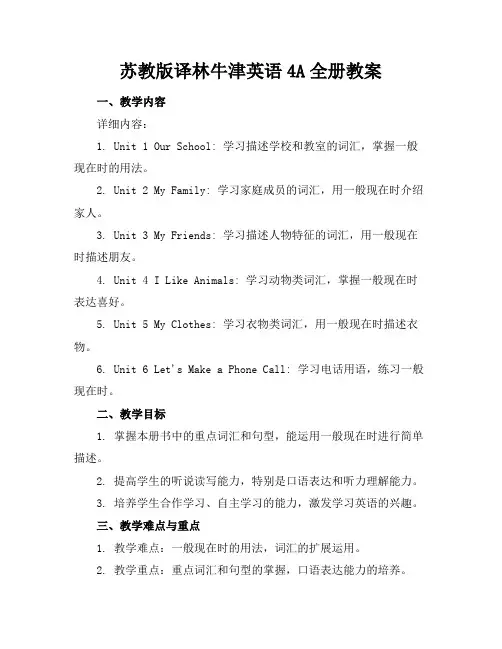
苏教版译林牛津英语4A全册教案一、教学内容详细内容:1. Unit 1 Our School: 学习描述学校和教室的词汇,掌握一般现在时的用法。
2. Unit 2 My Family: 学习家庭成员的词汇,用一般现在时介绍家人。
3. Unit 3 My Friends: 学习描述人物特征的词汇,用一般现在时描述朋友。
4. Unit 4 I Like Animals: 学习动物类词汇,掌握一般现在时表达喜好。
5. Unit 5 My Clothes: 学习衣物类词汇,用一般现在时描述衣物。
6. Unit 6 Let's Make a Phone Call: 学习电话用语,练习一般现在时。
二、教学目标1. 掌握本册书中的重点词汇和句型,能运用一般现在时进行简单描述。
2. 提高学生的听说读写能力,特别是口语表达和听力理解能力。
3. 培养学生合作学习、自主学习的能力,激发学习英语的兴趣。
三、教学难点与重点1. 教学难点:一般现在时的用法,词汇的扩展运用。
2. 教学重点:重点词汇和句型的掌握,口语表达能力的培养。
四、教具与学具准备1. 教具:PPT课件、卡片、录音机、磁带。
2. 学具:英语课本、练习册、字典、彩色笔。
五、教学过程1. 导入:通过PPT展示与单元主题相关的图片,引导学生讨论。
2. 新课:讲解重点词汇和句型,结合实践情景进行例句展示。
3. 例题讲解:针对难点和重点,设计相关例题进行讲解。
4. 随堂练习:让学生进行小组合作,完成随堂练习,巩固所学知识。
六、板书设计1. 重点词汇和句型2. 一般现在时的结构3. 例句展示七、作业设计1. 作业题目:a. 根据本节课所学的词汇,写一篇关于学校的短文。
b. 录制一段和家人介绍自己朋友的对话。
c. 选择一种动物,用一般现在时描述其特征。
2. 答案:见附件。
八、课后反思及拓展延伸2. 拓展延伸:a. 组织英语角活动,让学生运用所学词汇和句型进行交流。
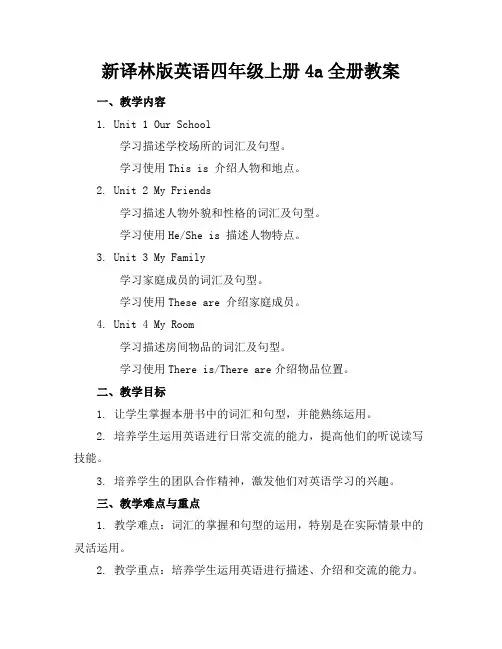
新译林版英语四年级上册4a全册教案一、教学内容1. Unit 1 Our School学习描述学校场所的词汇及句型。
学习使用This is 介绍人物和地点。
2. Unit 2 My Friends学习描述人物外貌和性格的词汇及句型。
学习使用He/She is 描述人物特点。
3. Unit 3 My Family学习家庭成员的词汇及句型。
学习使用These are 介绍家庭成员。
4. Unit 4 My Room学习描述房间物品的词汇及句型。
学习使用There is/There are介绍物品位置。
二、教学目标1. 让学生掌握本册书中的词汇和句型,并能熟练运用。
2. 培养学生运用英语进行日常交流的能力,提高他们的听说读写技能。
3. 培养学生的团队合作精神,激发他们对英语学习的兴趣。
三、教学难点与重点1. 教学难点:词汇的掌握和句型的运用,特别是在实际情景中的灵活运用。
2. 教学重点:培养学生运用英语进行描述、介绍和交流的能力。
四、教具与学具准备1. 教具:PPT课件、图片、卡片、录音机、磁带等。
2. 学具:英语课本、练习本、彩色笔等。
五、教学过程1. 引入:通过展示与单元主题相关的图片或视频,引导学生进行讨论,激发兴趣。
2. 呈现:展示PPT课件,呈现本节课的主要词汇和句型,进行讲解和示范。
3. 实践:组织学生进行小组活动,运用所学词汇和句型进行情景对话。
4. 练习:进行随堂练习,检查学生对词汇和句型的掌握情况。
5. 巩固:通过角色扮演、游戏等形式,巩固所学知识。
六、板书设计板书内容包括:本节课的主题、重点词汇、句型、练习题目及答案。
七、作业设计1. 作业题目:根据每个单元的主题,设计相关的练习题目,如填空、连线、翻译等。
2. 答案:提供详细的答案,以便学生进行自我检查。
八、课后反思及拓展延伸2. 拓展延伸:布置与课堂内容相关的拓展任务,如绘制主题海报、编写小故事等,提高学生的综合运用能力。
重点和难点解析一、教学内容的选择与安排重点关注各单元的主题内容与词汇、句型的关联性。
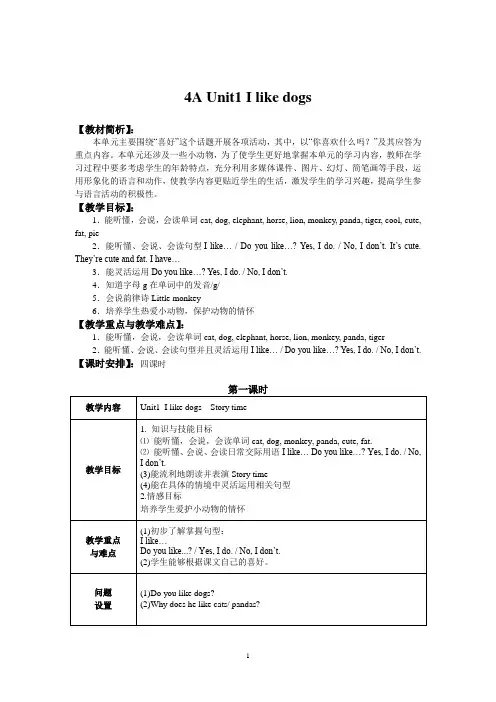
4A Unit1 I like dogs【教材简析】:本单元主要围绕“喜好”这个话题开展各项活动,其中,以“你喜欢什么吗?”及其应答为重点内容。
本单元还涉及一些小动物,为了使学生更好地掌握本单元的学习内容,教师在学习过程中要多考虑学生的年龄特点,充分利用多媒体课件、图片、幻灯、简笔画等手段,运用形象化的语言和动作,使教学内容更贴近学生的生活,激发学生的学习兴趣,提高学生参与语言活动的积极性。
【教学目标】:1.能听懂,会说,会读单词cat, dog, elephant, horse, lion, monkey, panda, tiger, cool, cute, fat, pie2.能听懂、会说、会读句型I like… / Do you like…? Yes, I do. / No, I don’t.It’s cute. They’re cute and fat. I have…3.能灵活运用Do you like…? Yes, I do. / No, I don’t.4.知道字母g在单词中的发音/g/5.会说韵律诗Little monkey6.培养学生热爱小动物,保护动物的情怀【教学重点与教学难点】:1.能听懂,会说,会读单词cat, dog, elephant, horse, lion, monkey, panda, tiger2.能听懂、会说、会读句型并且灵活运用I like… / Do you like…? Yes, I do. / No, I don’t.【课时安排】:四课时4A Unit2 let’s make a fruit salad【教材简析】:本单元主要围绕制作水果沙拉这个话题开展各项活动,其中,以询问对方有没有某种水果为重点内容。
为了使学生更好地掌握本单元的学习内容,教师在学习过程中用多种形式将对话进行操练,充分利用多媒体课件、图片、幻灯、简笔画等手段,运用形象化的语言和动作,使教学内容便于学生理解和吸收,激发学生的学习兴趣,提高课堂效率。

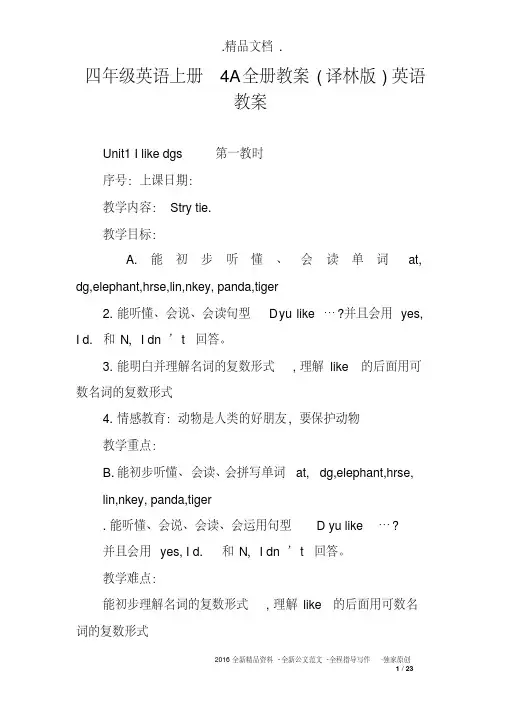
四年级英语上册4A全册教案(译林版)英语教案Unit1 I like dgs第一教时序号:上课日期:教学内容:Stry tie.教学目标:A.能初步听懂、会读单词at, dg,elephant,hrse,lin,nkey, panda,tiger2.能听懂、会说、会读句型 D yu like…?并且会用yes,I d.和N,I dn’t 回答。
3.能明白并理解名词的复数形式,理解like的后面用可数名词的复数形式4.情感教育:动物是人类的好朋友,要保护动物教学重点:B.能初步听懂、会读、会拼写单词at, dg,elephant,hrse,lin,nkey, panda,tiger.能听懂、会说、会读、会运用句型 D yu like…?并且会用yes, I d.和N,I dn’t 回答。
教学难点:能初步理解名词的复数形式,理解like的后面用可数名词的复数形式教学准备:挂图,卡片,PPT教学设计教学过程:Step 1 ar up1.Let’s sing : ld adnald has a farhat anials are n the far?hat ther anials are n the far?2.Play a gae: yes r nAre they n the far, t?D yu like the?( 通过游戏学习各种动物at ,dg, nkey, lin, panda, tiger, bear等,拓宽学生的知识面。
)Step 2 PresentatinA.出示课第一幅图片.1.Let’s talka. Are they n the far?b. h are they ? And where are they?B.wath the artn:1.hat are they ging t talk abut?They are talking abut ty anials.揭示课题: ty anials3.Try t sayListen t the radi.Listen t the teaher.Read tgether.B. Listen and tik1.Listen t the tape and tik what they are talkingabut.(听录音,勾出他们谈论的动物。
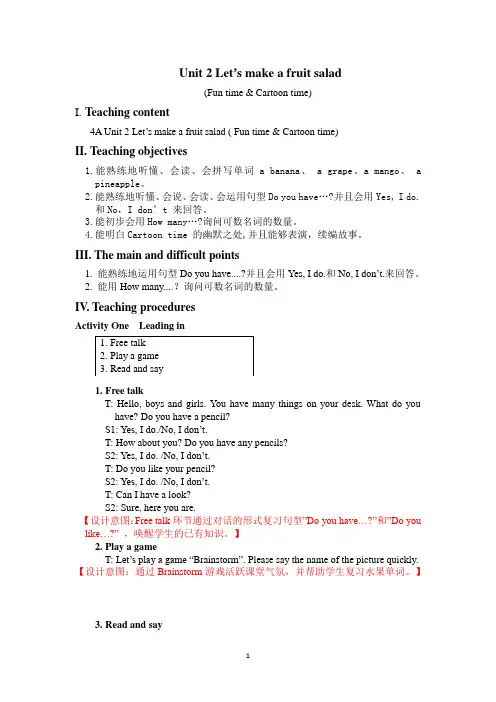
Unit 2 Let’s make a fruit salad(Fun time & Cartoon time)I.Teaching content4A Unit 2 Let’s make a fruit salad ( Fun time & Cartoon time)II.Teaching objectives1.能熟练地听懂、会读、会拼写单词 a banana、 a grape、a mango、 apineapple。
2.能熟练地听懂、会说、会读、会运用句型Do you have…?并且会用Yes, I do.和No,I don’t 来回答。
3.能初步会用How many…?询问可数名词的数量。
4.能明白Cartoon time 的幽默之处,并且能够表演,续编故事。
III. The main and difficult points1. 能熟练地运用句型Do you have....?并且会用Yes, I do.和No, I don’t.来回答。
2. 能用How many....?询问可数名词的数量。
IV. Teaching proceduresActivity One Leading in1.Free talkT: Hello, boys and girls. You have many things on your desk. What do youhave? Do you have a pencil?S1: Yes, I do./No, I don’t.T: How about you? Do you have any pencils?S2: Yes, I do. /N o, I don’t.T: Do you like your pencil?S2: Yes, I do. /No, I don’t.T: Can I have a look?S2: Sure, here you are.【设计意图:Free talk环节通过对话的形式复习句型”Do you have…?”和”Do you like…?” ,唤醒学生的已有知识。
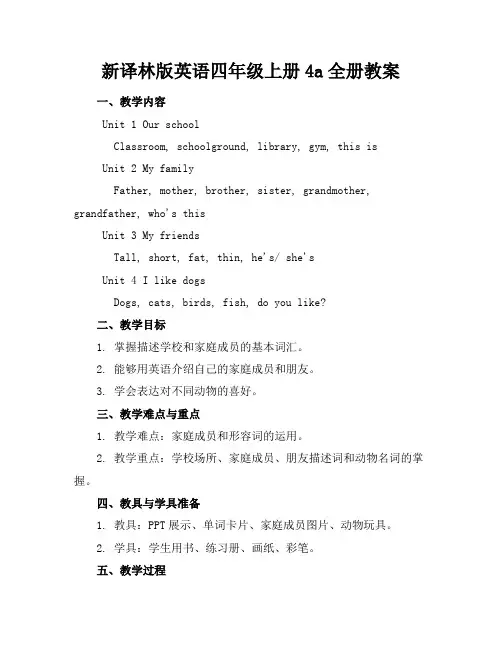
新译林版英语四年级上册4a全册教案一、教学内容Unit 1 Our schoolClassroom, schoolground, library, gym, this isUnit 2 My familyFather, mother, brother, sister, grandmother, grandfather, who's thisUnit 3 My friendsTall, short, fat, thin, he's/ she'sUnit 4 I like dogsDogs, cats, birds, fish, do you like?二、教学目标1. 掌握描述学校和家庭成员的基本词汇。
2. 能够用英语介绍自己的家庭成员和朋友。
3. 学会表达对不同动物的喜好。
三、教学难点与重点1. 教学难点:家庭成员和形容词的运用。
2. 教学重点:学校场所、家庭成员、朋友描述词和动物名词的掌握。
四、教具与学具准备1. 教具:PPT展示、单词卡片、家庭成员图片、动物玩具。
2. 学具:学生用书、练习册、画纸、彩笔。
五、教学过程1. 导入:通过PPT展示学校不同场所的图片,引导学生用英语描述。
引入新单词,进行快速问答游戏,巩固新词汇。
2. 新课内容:利用单词卡片,教授家庭成员和形容词。
通过角色扮演,让学生介绍自己的家庭成员。
3. 例题讲解:以Unit 3 My friends为例,讲解如何用英语描述朋友的外貌特征。
4. 随堂练习:分组活动,让学生互相描述对方的外貌,并进行角色扮演。
5. 小结:六、板书设计1. 新译林版英语四年级上册4a全册2. 内容:Unit 1:学校场所词汇Unit 2:家庭成员词汇Unit 3:朋友描述词Unit 4:动物名词七、作业设计1. 作业题目:根据所学内容,用英语写一篇关于自己学校和家庭成员的短文。
画出自己和朋友的外貌,并用英语描述。
2. 答案:短文示例:Our school is very beautiful. It has a classroom, a schoolground, a library and a gym. My family has six members. They are my father, mother, brother, sister, grandmother and grandfather.朋友外貌描述示例:My friend is tall and thin. He has black hair and big eyes.八、课后反思及拓展延伸1. 教师反思:关注学生对家庭成员和动物名词的掌握程度,调整教学方法和进度。
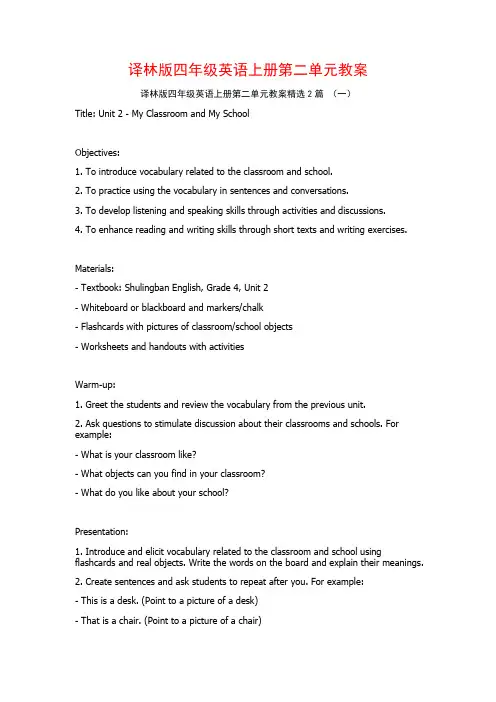
译林版四年级英语上册第二单元教案译林版四年级英语上册第二单元教案精选2篇(一)Title: Unit 2 - My Classroom and My SchoolObjectives:1. To introduce vocabulary related to the classroom and school.2. To practice using the vocabulary in sentences and conversations.3. To develop listening and speaking skills through activities and discussions.4. To enhance reading and writing skills through short texts and writing exercises.Materials:- Textbook: Shulingban English, Grade 4, Unit 2- Whiteboard or blackboard and markers/chalk- Flashcards with pictures of classroom/school objects- Worksheets and handouts with activitiesWarm-up:1. Greet the students and review the vocabulary from the previous unit.2. Ask questions to stimulate discussion about their classrooms and schools. For example:- What is your classroom like?- What objects can you find in your classroom?- What do you like about your school?Presentation:1. Introduce and elicit vocabulary related to the classroom and school using flashcards and real objects. Write the words on the board and explain their meanings.2. Create sentences and ask students to repeat after you. For example:- This is a desk. (Point to a picture of a desk)- That is a chair. (Point to a picture of a chair)Practice:1. Divide the class into pairs or small groups.2. Give each group a set of flashcards or pictures of classroom/school objects.3. Ask each group to arrange the flashcards in different ways, such as by category(e.g., furniture, stationery) or by size (e.g., big, small).4. In rotations, have groups present their arrangements and describe them using the target vocabulary. Encourage students to use complete sentences.5. Monitor and provide guidance as needed.Listening:1. Play a recording of a short conversation about a classroom or school.2. Ask students to listen and answer questions related to the conversation.3. Play the recording again if necessary.4. Discuss the answers as a class.Reading:1. Provide short texts about a classroom or school.2. Ask students to read the texts individually or in pairs.3. Have a class discussion about the texts, focusing on comprehension and key details.4. Ask comprehension questions to check understanding.Writing:1. Provide worksheets with exercises to practice writing sentences using the target vocabulary.2. Have students complete the exercises individually or in pairs.3. Review and discuss the answers as a class.Homework:1. Assign writing tasks where students describe their classrooms or schools using the target vocabulary.2. Encourage students to use complete sentences and include as many details as possible.Assessment:1. Observe and assess students' participation and comprehension during class discussions and activities.2. Review completed worksheets and writing assignments for accuracy and understanding.Notes:- Adapt the lesson plan according to the needs and abilities of the students.- Include additional activities and games to make the lesson more interactive and engaging.- Provide extra support for struggling students and challenge the advanced learners with additional tasks.译林版四年级英语上册第二单元教案精选2篇(二)Unit 1: HelloLesson 1: Greeting and IntroductionsObjectives:- Students will be able to greet and introduce themselves in English.- Students will be able to ask and answer simple questions about personal information.Materials:- Greeting cards with different expressions (e.g. hello, hi, good morning, etc.)- Flashcards of people with names on them- Pictures of different daily activities (e.g. eat, play, sleep, etc.)Procedure:1. Warm-up (5 minutes)- Greet the students with different expressions (e.g. hello, hi, good morning, etc.) and ask them how they are doing.- Ask some students to greet the class using different expressions.2. Introduction (10 minutes)- Show the flashcards of people with names on them. Ask the students to name the people on the flashcards.- Introduce yourself using the flashcards (e.g. Hello, my name is Mark).- Have the students repeat after you and introduce themselves using the flashcards (e.g. Hello, my name is Sarah).3. Vocabulary (15 minutes)- Show the pictures of different daily activities.- Teach and practice the vocabulary words for each activity.- Have the students repeat the words after you and practice using them in sentences (e.g. I eat breakfast in the morning).4. Pair Work (15 minutes)- Divide the class into pairs.- Give each pair a set of greeting cards.- In their pairs, students will take turns choosing a greeting card and using it to greet their partner. They will then introduce themselves and ask and answer questions about their daily activities.5. Group Activity (15 minutes)- Divide the class into larger groups.- Give each group a set of flashcards and pictures of daily activities.- In their groups, students will take turns picking a flashcard and a picture. They will then introduce the person on the flashcard and tell the group what activity they do (e.g. This is Sarah. She eats breakfast in the morning).6. Wrap-up (5 minutes)- Review the vocabulary and expressions learned in the lesson.- Ask students to share one thing they learned about a classmate during the pair and group activities.Assessment:- Observe students' participation and ability to greet and introduce themselves.- Listen for correct pronunciation and usage of vocabulary words.- Monitor students' ability to ask and answer questions about personal information.。

译林版英语四年级上册U n i t2教案怀文小学教案专用纸Step 1. Greeting and warming up.T:Nice to see you.S: Nice to see you too.T: Let’s enjoy our English lessons now. Let’s sing a song, OK? Follow me(加动作):Apple treeStep 2.Presentation.1.Free talk:T:Do you know the name of the song? It’s appletree. Do you like apples?S:Yes,I do.(用Unit1的句型复习已学水果单词)2.出示标题。
Apples, pears and oranges are all fruit.Let’s make a fruit salad.Step3. Watch the cartoon.1.Watch and answer: What fruit can you see ?S: I can see a /an/ some…教授单词:banana ,grape, mango, pineapple, fruit. T:I have a/an…(老师出示单词卡或实物). Do you have a banana/grape/mango/pineapple?S:Yes,I do. /No, I don’t.2.Practice先师生问答,再学生分组操练。
T:Do you have …?S:Yes, I do.No, I don’t.板书句型。
让学生发现此句型与第一单元句型的异同之处。
总结Do you…?的回答用语。
Step 4. Reading time1.Read and say.快速阅读课文,身处课文,说说每个人有什么水果。
I’m…I have…2.学生逐图跟读,提醒注意模仿语音语调。
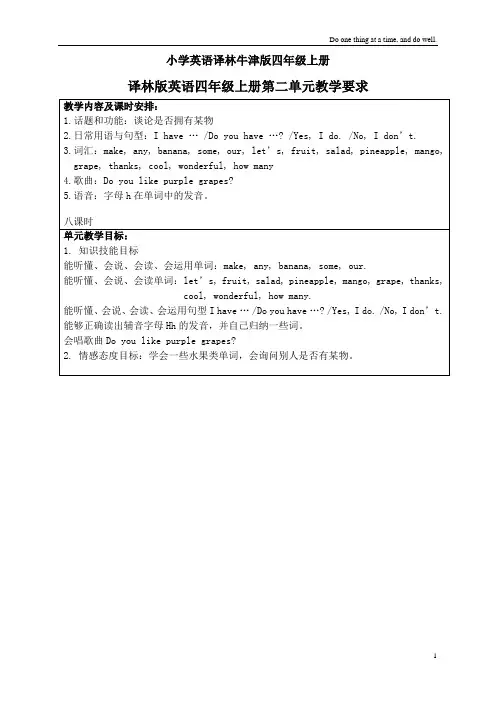
小学英语译林牛津版四年级上册
译林版英语四年级上册第二单元教学要求
译林版英语四年级上册第二单元教学设计方案NO:1
译林版英语四年级上册第二单元教学设计方案NO:2
译林版英语四年级上册第二单元教学设计方案NO:3
译林版英语四年级上册第二单元教学设计方案NO:4
例如: What
译林版英语四年级上册第二单元教学设计方案NO:5
you ? , I .
7.Read by yourself
译林版英语四年级上册第二单元教学设计方案NO:6
s this girl? Let
s Helen.
译林版英语四年级上册第二单元教学设计方案NO:7
译林版英语四年级上册第二单元教学设计方案NO:8。
说明:1、重点突出板块设计;
2、备课时重点突出教学设计(包括教师与学生活动设计)
3、教学反思在“活动目标及达成情况”栏填写。
说明:1、重点突出板块设计;
2、备课时重点突出教学设计(包括教师与学生活动设计)
3、教学反思在“活动目标及达成情况”栏填写。
说明:1、重点突出板块设计;
2、备课时重点突出教学设计(包括教师与学生活动设计)
3、教学反思在“活动目标及达成情况”栏填写。
说明:1、重点突出板块设计;
2、备课时重点突出教学设计(包括教师与学生活动设计)
3、教学反思在“活动目标及达成情况”栏填写。
单元课题Unit 2 Let’s make a fruit salad 主备教师教学目标知识目标1.能初步听懂、会读、会拼写单词make,great, have,any,some, banana, our, nice2.能听懂、会说、会读、会运用句型I have … Do you have …? 并且会用Yes, Ido./No, I don’t.来回答。
3. 能明白并理解some和any 的用法。
能力目标1.能初步听懂、会读、会拼写单词make,great, have,any,some, banana, our, nice2.能听懂、会说、会读、会运用句型I have … Do you have …? 并且会用Yes, Ido./No, I don’t.来回答。
3. 能明白并理解some和any 的用法。
情感目标学会与他人分享。
教学重点1.能初步听懂、会读、会拼写单词make, great, have, any, some, banana, our,nice2.能听懂、会说、会读、会运用句型I have … Do you have …? 并且会用Yes, Ido./No, I don’t.来回答。
3. 能明白并理解some和any 的用法。
教学难点1.能初步听懂、会读、会拼写单词make, great, have, any, some, banana, our,nice2.能听懂、会说、会读、会运用句型I have … Do you have …? 并且会用Yes, Ido./No, I don’t.来回答。
3. 能明白并理解some和any 的用法。
教学课时安排第一课时 Story time第二课时 Fun time第三课时 Cartoon time第四课时 Sound time/Checkout time 第五课时单元测试第六课时单元测试分析第一课时(Story time)教学目标1.能初步听懂、会读、会拼写单词banana, grape, mango, pineapple, nice, make,salad, some, any2.能听懂、会说、会读、会运用句型I have … Do you have …? 并且会用Yes, Ido./No, I don’t.来回答。
新译林版英语四年级上册4a全册教案一、教学内容1. Unit 1 Our schoolChapter 1: School subjectsChapter 2: School facilitiesChapter 3: Afterschool activities2. Unit 2 My familyChapter 1: Family membersChapter 2: Family activitiesChapter 3: Family photos3. Unit 3 My friendsChapter 1: Describing friendsChapter 2: Friends' hobbiesChapter 3: Making new friends4. Unit 4 I like dogsChapter 1: Animals and their featuresChapter 2: Animal habitatsChapter 3: Taking care of animals二、教学目标1. 能够熟练运用本册教材中的词汇和句型,进行简单的英语交流和表达。
3. 培养学生的团队合作意识,提高课堂参与度和积极性。
三、教学难点与重点1. 教学难点:词汇的准确运用和句型的熟练掌握。
2. 教学重点:培养学生的英语听说读写能力,提高课堂互动和参与度。
四、教具与学具准备1. 教具:PPT课件、磁带、录音机、卡片、挂图等。
2. 学具:课本、练习册、文具等。
五、教学过程1. 导入:通过情景引入,展示与单元主题相关的图片或实物,引导学生用英语进行讨论。
2. 新课内容展示:展示新课的词汇、句型,结合PPT课件和挂图进行讲解。
3. 例题讲解:针对重点词汇和句型,设计例题进行讲解,帮助学生理解。
4. 随堂练习:设计形式多样的练习题,让学生在课堂上进行巩固。
5. 小组活动:分组进行角色扮演、讨论等活动,培养学生的团队合作意识。
2024年新译林版英语四年级上册4a全册教案一、教学内容二、教学目标1. 掌握并运用本册书中的重点词汇和句型,如:school,classroom,friend,family,clothes,food等。
2. 能够用英语简单介绍自己的学校、朋友、家人以及日常生活。
3. 培养学生的听说读写能力,提高他们英语实际运用水平。
三、教学难点与重点1. 教学重点:本册书中的重点词汇、句型以及日常英语对话。
2. 教学难点:名词复数形式、一般现在时态以及描述性词汇的运用。
四、教具与学具准备1. 教具:PPT、卡片、录音机、磁带等。
2. 学具:课本、练习本、彩笔、剪刀、胶水等。
五、教学过程1. 导入:通过展示与单元主题相关的图片或视频,引起学生的兴趣,导入新课。
2. 新课内容展示:呈现新课词汇、句型,让学生跟随录音朗读,教师进行讲解。
3. 实践活动:设置实践情景,让学生分组进行对话练习,巩固所学内容。
4. 例题讲解:针对本节课的重点难点,进行例题讲解,让学生进一步理解。
5. 随堂练习:设计针对性的练习题,让学生当堂巩固所学知识。
六、板书设计1. 新课词汇、句型。
2. 重点语法点。
3. 例题及解答。
七、作业设计1. 作业题目:(1)抄写本节课所学词汇,每个单词写5遍。
(2)用一般现在时态写一段话,介绍自己的学校、朋友或家人。
(3)完成练习册相关练习。
2. 答案:八、课后反思及拓展延伸1. 课后反思:针对本节课的教学效果,反思教学方法、手段以及学生掌握程度,为下一节课做好准备。
2. 拓展延伸:布置学生进行课后调查、采访等实践活动,如了解家人的兴趣爱好、制作学校地图等,提高学生的实际运用能力。
同时,鼓励学生课外阅读英语绘本,观看英语动画片,提高英语素养。
重点和难点解析1. 教学内容的章节和详细内容。
2. 教学目标的具体制定。
3. 教学难点与重点的区分。
4. 教学过程中的实践情景引入、例题讲解和随堂练习设计。
5. 板书设计的简洁明了性。
Unit1 I like dogsUnit2 Let’s make a fruit salad教学内容Unit2 Let’smake a fruitsalad课型新授课执教者第( 2 )课时教学目标1.能熟练地听懂、会读、会拼写单词 a banana、 a grape、a mango、 a pineapple;复习水果类单词an orange, a peach,a pear,an apple。
2.能熟练地听懂、会说、会读、会运用句型Do you have…?并且会用Yes, I do.和No,I don’t 来回答。
3.能初步会用How many…?询问可数名词的数量。
4.能明白Cartoon time 的幽默之处教学重点 1.能熟练地听懂、会读、会拼写单词 a banana、 a grape、a mango、 a pineapple;复习水果类单词an orange, a peach,apear,an apple。
2.能熟练地听懂、会说、会读、会运用句型Do you have…?并且会用Yes, I do.和No,I don’t 来回答。
3.能初步会用How many…?询问可数名词的数量。
4.能明白Cartoon time 的幽默之处5.复习数字1-12教学难点能初步会用How many…?询问可数名词的数量。
教学疑点学生能否理解many 和some与any的区别,是否要渗透much 不可数名词数量的试用?教学准备挂图,卡片,多媒体(PPT)教学过程三备Step 1 Greeing and warm up1.Dictation2.GreetingT: Good morning, boys and girls. How are you?S: I’m fine/well/good/Not so good…3.Warm up(1)Question box教师出示一个盒子----Question box,盒子里装了过去所学的问题,让学生在盒子一抽出一张纸回答问题。